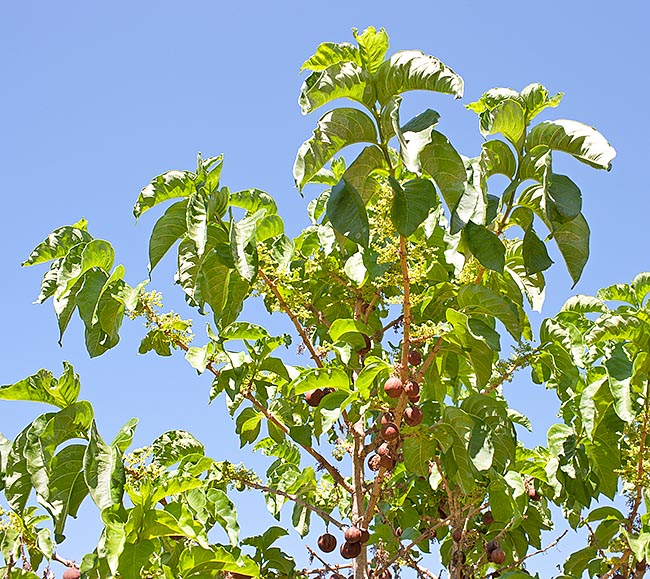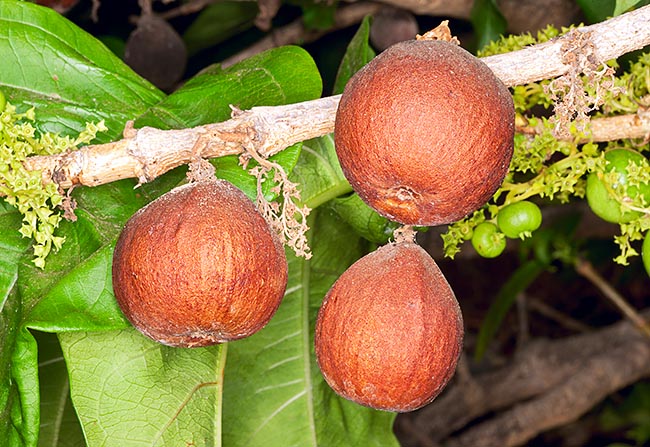Family : Rubiaceae

Text © Pietro Puccio

English translation by Mario Beltramini

Vangueria madagascariensis is a very ramified small tree that may reach 8 m © G. Mazza
The species is native to Angola, Benin, Cameroon, Central African Republic, Chad, Democratic Republic of the Congo, Ethiopia, Ghana, Kenya, Madagascar, Malawi, Mali, Mozambique, Nigeria, South Africa, Sudan, Swaziland, Tanzania and Uganda, where it grows in the evergreen forests usually in free spaces, and in the savannahs on rocky as well as sandy soils, from the sea level up to about 2000 m of altitude.
The name of the genus comes from the Malagasy “voa vanguer” of the species; the Latin name of the species “madagascariensis” = of Madagascar, refers to one of its places of origin.
Common names: African tamarind, Spanish tamarind, tamarind-of-the-Indies, voa vanga, vavangue tree (English); tamarin des Indes, tamarinier des Indes, vavangue, voavanguier (French); tamarindo extranjero, tamarindo forastero (Spanish); muiru, mviru (Swahili).
The Vangueria madagascariensis J.F.Gmel (1791) is a shrub or small deciduous tree, much ramified, up to about 8 m tall and trunk having a brown grey bark.
The leaves, on a 0,5-1,5 cm long petiole, are simple opposite, obovate to ovate-lanceolate with entire margin, of intense green colour on the upper page, pale green with prominent nervations below, 8-24 cm long and 4-12 cm broad with obtuse or pointed apex.
The inflorescences, on an about 0,6 cm long peduncle, are dense axillary cymes carrying tiny flowers with 4-5 lobes calyx, campanulate-globose corolla, 0,5 cm long, with 4-5 pale yellowish green lobes. The fruits are globose-depressed drupes of 3-5 cm of diameter, of glossy green colour spotted of white tending to yellowish brown when well ripe, with 4-5 cells containing each one an about 1,6 cm long seed surrounded by a brownish pasty pulp; the ripe fruit remain for long time on the tree.

The edible fruits taste of tamarind and chocolate. Roots and bark are medicinal © Giuseppe Mazza
It reproduces by seed and by cutting, the seed is to be previously scarified and dipped in water for one day, as it has a particularly hard tegument, and then planted in organic loam with addition of coarse sand, kept humid at the temperature of 22-24 °C, with germination times of 1-2 months.
Species diffused in the wild, but only occasionally cultivated in gardens and family orchards, suitable exclusively to tropical and subtropical climates, as it does not bear temperatures close to 0 °C even for a short period; it requires full sun and is not particular about the soil, even if poor, provided well drained, and can resist, well rooted, to long drought periods.
The brownish pulp surrounding the seeds is edible only when the fruits are fully ripe, with a slightly acidulous taste reminding that of the tamarind or at times the chocolate’s, mainly consumed by the children.
The wood is utilized as construction material and for making tools, locally much appreciated as fuel or for producing charcoal. The roots and the bark are utilized, as decoctions, in the traditional medicine for various pathologies.
Synonyms: Vavanga chinensis Rohr (1792); Vavanga edulis Vahl (1792); Vangueria edulis (Vahl) Vahl (1794); Vangueria commersonii Jacq. (1797); Vangueria cymosa C.F. Gaertn. (1805); Vangueria edulis Lam. (1819); Canthium edule (Vahl) Baill. (1878); Vangueria acutiloba Robyns (1928); Vangueria floribunda Robyns (1928); Vangueria venosa Robyns (1928); Canthium maleolens Chiov. (1939); Vangueria robynsii Tennant (1968).
→ To appreciate the biodiversity within the RUBIACEAE family please click here.
